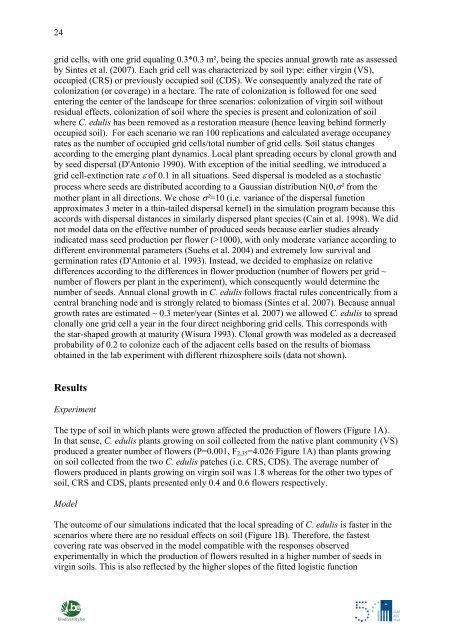Science Facing Aliens - Invasive Alien Species in Belgium - Belgian ...
Science Facing Aliens - Invasive Alien Species in Belgium - Belgian ...
Science Facing Aliens - Invasive Alien Species in Belgium - Belgian ...
Create successful ePaper yourself
Turn your PDF publications into a flip-book with our unique Google optimized e-Paper software.
24<br />
grid cells, with one grid equal<strong>in</strong>g 0.3*0.3 m², be<strong>in</strong>g the species annual growth rate as assessed<br />
by S<strong>in</strong>tes et al. (2007). Each grid cell was characterized by soil type: either virg<strong>in</strong> (VS),<br />
occupied (CRS) or previously occupied soil (CDS). We consequently analyzed the rate of<br />
colonization (or coverage) <strong>in</strong> a hectare. The rate of colonization is followed for one seed<br />
enter<strong>in</strong>g the center of the landscape for three scenarios: colonization of virg<strong>in</strong> soil without<br />
residual effects, colonization of soil where the species is present and colonization of soil<br />
where C. edulis has been removed as a restoration measure (hence leav<strong>in</strong>g beh<strong>in</strong>d formerly<br />
occupied soil). For each scenario we ran 100 replications and calculated average occupancy<br />
rates as the number of occupied grid cells/total number of grid cells. Soil status changes<br />
accord<strong>in</strong>g to the emerg<strong>in</strong>g plant dynamics. Local plant spread<strong>in</strong>g occurs by clonal growth and<br />
by seed dispersal (D'Antonio 1990). With exception of the <strong>in</strong>itial seedl<strong>in</strong>g, we <strong>in</strong>troduced a<br />
grid cell-ext<strong>in</strong>ction rate ε of 0.1 <strong>in</strong> all situations. Seed dispersal is modeled as a stochastic<br />
process where seeds are distributed accord<strong>in</strong>g to a Gaussian distribution N(0,σ² from the<br />
mother plant <strong>in</strong> all directions. We chose σ²=10 (i.e. variance of the dispersal function<br />
approximates 3 meter <strong>in</strong> a th<strong>in</strong>-tailed dispersal kernel) <strong>in</strong> the simulation program because this<br />
accords with dispersal distances <strong>in</strong> similarly dispersed plant species (Ca<strong>in</strong> et al. 1998). We did<br />
not model data on the effective number of produced seeds because earlier studies already<br />
<strong>in</strong>dicated mass seed production per flower (>1000), with only moderate variance accord<strong>in</strong>g to<br />
different environmental parameters (Suehs et al. 2004) and extremely low survival and<br />
germ<strong>in</strong>ation rates (D'Antonio et al. 1993). Instead, we decided to emphasize on relative<br />
differences accord<strong>in</strong>g to the differences <strong>in</strong> flower production (number of flowers per grid ~<br />
number of flowers per plant <strong>in</strong> the experiment), which consequently would determ<strong>in</strong>e the<br />
number of seeds. Annual clonal growth <strong>in</strong> C. edulis follows fractal rules concentrically from a<br />
central branch<strong>in</strong>g node and is strongly related to biomass (S<strong>in</strong>tes et al. 2007). Because annual<br />
growth rates are estimated ~ 0.3 meter/year (S<strong>in</strong>tes et al. 2007) we allowed C. edulis to spread<br />
clonally one grid cell a year <strong>in</strong> the four direct neighbor<strong>in</strong>g grid cells. This corresponds with<br />
the star-shaped growth at maturity (Wisura 1993). Clonal growth was modeled as a decreased<br />
probability of 0.2 to colonize each of the adjacent cells based on the results of biomass<br />
obta<strong>in</strong>ed <strong>in</strong> the lab experiment with different rhizosphere soils (data not shown).<br />
Results<br />
Experiment<br />
The type of soil <strong>in</strong> which plants were grown affected the production of flowers (Figure 1A).<br />
In that sense, C. edulis plants grow<strong>in</strong>g on soil collected from the native plant community (VS)<br />
produced a greater number of flowers (P=0.001, F2,35=4.026 Figure 1A) than plants grow<strong>in</strong>g<br />
on soil collected from the two C. edulis patches (i.e. CRS, CDS). The average number of<br />
flowers produced <strong>in</strong> plants grow<strong>in</strong>g on virg<strong>in</strong> soil was 1.8 whereas for the other two types of<br />
soil, CRS and CDS, plants presented only 0.4 and 0.6 flowers respectively.<br />
Model<br />
The outcome of our simulations <strong>in</strong>dicated that the local spread<strong>in</strong>g of C. edulis is faster <strong>in</strong> the<br />
scenarios where there are no residual effects on soil (Figure 1B). Therefore, the fastest<br />
cover<strong>in</strong>g rate was observed <strong>in</strong> the model compatible with the responses observed<br />
experimentally <strong>in</strong> which the production of flowers resulted <strong>in</strong> a higher number of seeds <strong>in</strong><br />
virg<strong>in</strong> soils. This is also reflected by the higher slopes of the fitted logistic function


